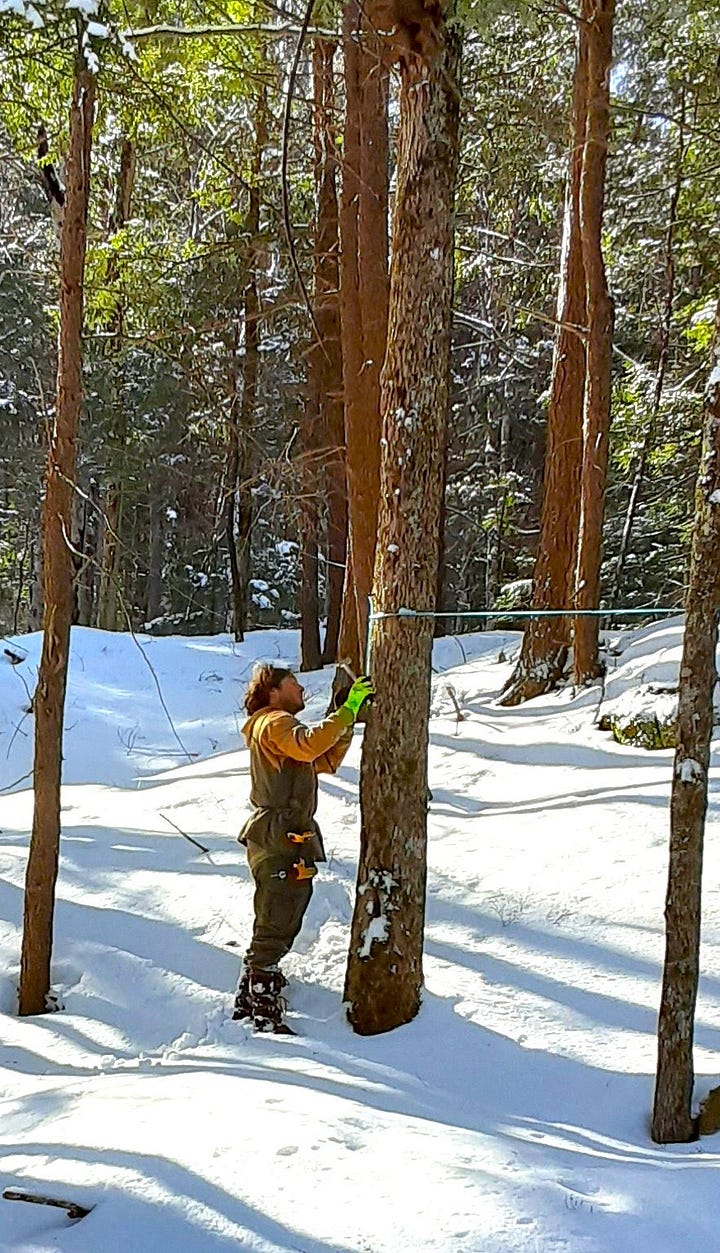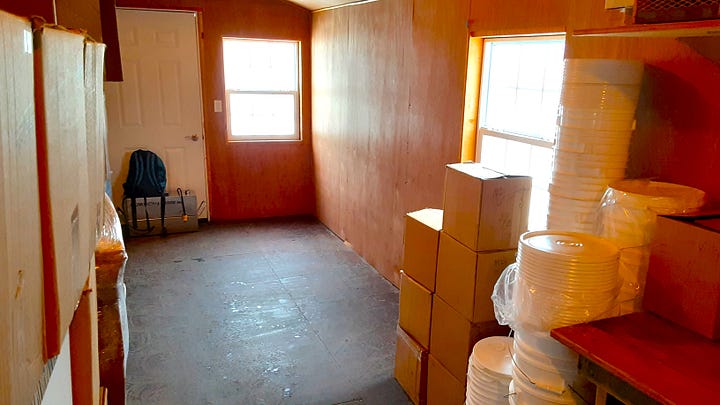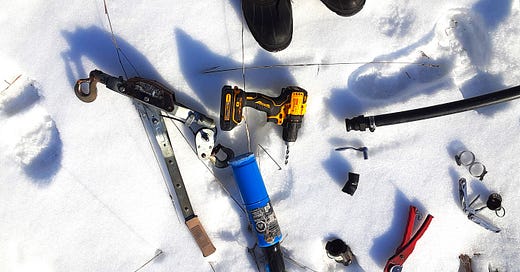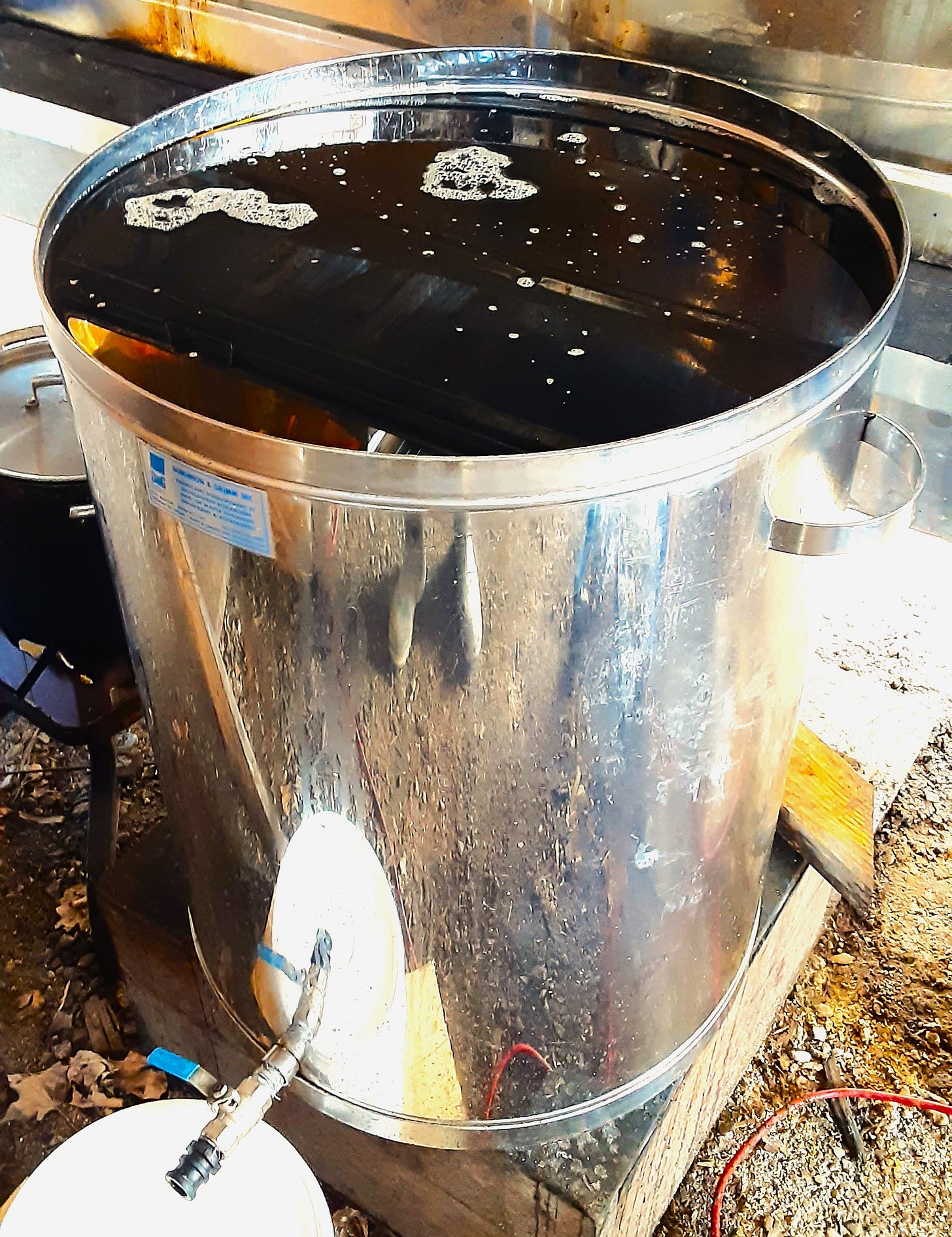A feeling of dread clouded my mood as the 2024 maple season approached. The winter had been so mild – the second such winter in a row. After last year’s “fake” winter, we had had our lowest production yet. The trees didn’t strike me as particularly healthy looking, either. Maybe it was just my imagination, brought on by my general gloom (no doubt amplified by world events), but there seemed to be a larger number than usual of trees with dead or dying branches, blooming fungi.
The weather had also been unpredictable, flirting with real winter temperatures of -20°C one week, then flipping back to highs above zero the next. I knew that if we tapped the trees during some of those abnormally warm days in January that the sap would be flowing, as indeed some maple producers in places to the south of us did – some even tapping in December (and grumbling over having to work over the holidays).
But we didn’t want to tap too soon, which would bring its own set of problems. We had learned this the hard way last year, when a thaw in mid-February caused us to quickly get all 2800 of our taps in in time to catch this first run. We had to hire extra hands to tap quickly, and in the end, we only got enough sap to do one boil, which was too brief to actually make any syrup from. Then things froze up again for the next month, and we were left with massive ice cubes of sap in our tanks, which took forever to thaw once the weather warmed again.
Also, taps generally have a lifespan of about two months, after which the natural healing of the tree closes the tapholes, so we didn’t want to drill too soon and miss out on the end of the season.
The cover headline in the Maple News – an industry rag we get – was “Sugarmakers fret over when to tap”. Here’s the first few sentences:
“When to tap? That’s always the sugarmaker dilemma every season but this year it seems more pronounced than others. Wild weather and big temperature swings has had producers excited one minute and hesitant the next.”
We heard from one producer in the Eastern Townships that he had already made a third of his expected crop. FOMO (Fear Of Missing Out) is intense in the maple industry.
But still we waited a bit longer than last year to begin tapping. When we saw a sustained warm stretch approaching, I got out my drill and hammer and swung into action February 19. Alex, who worked for us last summer, flew back from his vacation in Mexico just in time to join me in the woods a few days later.


Richard, our equipment dealer and a 4000-tap producer in Val-des-Monts, asked if we were all tapped, and when I said “Not yet”, he said “That’s not good”, and asked if we needed help. We declined, but the interaction added to my FOMO.
But a week after starting we finished tapping. It had gone faster than usual, as this was the first year we could walk around the woods without snowshoes on. We had had a big dump of snow in mid-January, but literally nothing since then – all the precipitation had come as rain. It was disorienting to look around at the relative lack of snow and realize this was just the beginning of the season; it looked more like mid-to-late season. Canada geese flying overhead added to the season-distorting confusion.
We probably could have caught a bit more early sap had we managed to get ourselves tapped a day or two earlier, but no use crying over missed sap. By February 28 our first boil was underway. It was the second earliest we had ever boiled (we first lit the evaporator on February 17 the year before).
But unlike the previous year, where we had one super-early boil but then hit the pause button for another month, we were off to the races once the fire was lit. We boiled 14 out of the next 20 days. On March 12 the trees were giving about half a litre of sap an hour, which meant that a tank that would typically take about 12 hours to fill up was topping out in less than three. The next day we had a marathon 13-hour boil, during which we bottled 474 litres of syrup – our second-highest total ever (it was probably our biggest single production day, actually, since we put another 90 litres that we didn’t have time to bottle in an overflow tank).
I created a new list of “Record Days” – a hit parade of 300L+ days. Before this year, we had had ten of them in the decade we had been making syrup professionally. In our best year to date, 2022, when we made nearly 5,000 litres of syrup, we had had three such days. This year, during a little over a week in early March, we had four of them.
It was during this run that I started thinking maybe this year wouldn’t be so bad after all. By March 15 we had already made more syrup than we had all of last year; in fact we hadn’t even begun to make any syrup until March 16 the year before. We put in an order to Richard for another pallet of bottles.


All seems well with the world when you’re making tons of maple syrup. Your life becomes focused on one goal – a welcome relief from the usual multi-tasking our modern lives demand. The black cloud that had been hovering over me lifted. It probably helped that I didn’t have time to follow the news cycle anymore – it being eclipsed by the freeze-thaw cycle that drives the maple sap flow. Dwarfing all our petty human dramas, the rhythms of nature and the universe pulse on. If you ever feel depressed by the news, just watch the clouds for a little while. Or make maple syrup.
The only problem was that we had been working for 23 days straight. And these were not puny eight hour shifts – they were typically in the double digits, racking up 75-hour work weeks. So it was a welcome relief when snow and winter weather hit March 18 and stuck around for the next week – a sugarmaker’s March Break.
Then we were back at it for Round Two. We were trying something different this year with our staffing. Normally, we hire someone to do most of the bottling, while Genevieve and I take turns working at the evaporator, stoking the fire and drawing off syrup, or working in the woods, fixing leaks in the tubing. This year, we split the bottling and evaporator work, and gave the woods work to Alex. Except Alex and I did such a good job tapping and fixing the early leaks, that our vacuum levels were holding unusually high and steady, and there was very little leak repair needed.
So we put Alex in charge of simply feeding the fire – something you need to do every ten minutes or so. This proved valuable, especially considering how much wood we needed to burn. We always have 60 cords of softwood (which an arborist dumps here from trees he has cut) on hand to meet the needs of what we believed to be the biggest possible season. But it was looking like even this might not be enough. Fortunately we also had a small mountain of split wood, which was supposed to be for next year. Much of it wasn’t very dry, but we could dip into it if things got desperate.
It was also good, considering I was a few weeks shy of turning 50, to have Alex, half my age, doing the more physically demanding work. I definitely feel the wear and tear of the daily grind a little more each spring, but having Alex around allowed me to occasionally enjoy the luxury of running out of things to do. But between adjusting the osmosis, drawing off syrup, checking its density, filtering, helping with the bottling, pumping out tanks, and general cleaning, such moments were still rare.
By this point the woods had been bare of snow for several weeks, and the leaves on the forest floor were tinder dry. We’ve always had a few sparks fly out of the chimney of our sugar shack, but this year the sparks found a fuel source. Fortunately we noticed the meter square fire before it got out of hand. We rushed over with buckets of water to douse it. Perhaps an investment in a spark guard for the chimney is in order for next year.
While Round One lasted three weeks, Round Two lasted another couple. About a week into it we started making dark syrup – one sign that the season was in its last act – and passed the 5,000 litre mark, making this our best season yet. On April 7 we boiled up the last of some very dark cooking grade syrup, and brought our season total to 5,250 litres – nearly two litres per tap.
We had boiled for 23 days total – two more than our previous record setting 2022 season – and had to dip into next year’s wood supply for the first time.
While we got lots of sap, its sugar content was low. Last year, the percentage of sugar in the sap stayed above 2% – even hitting 3% – for all but the final three days of the season. This year it peaked at 2.5% early on, then went downhill from there, staying below 2% for most of the season, and even hitting 1% at the very end (this is the same sugar content as birch sap). From what I hear, this was common for sugarmakers across the region. Maybe it was the dearth of sunny days last summer that made it difficult for maples to use the sun’s energy to fuse carbon dioxide and water together into sugars and store them in their roots. Perhaps there is some longer term trend, portending a decline in sugar maples’ health, that we should be worried about. Or perhaps it is just a one-year dip. Trees live on longer timelines than mere humans, and we shouldn’t read too much into one season.
Some nagging doubts about the trees’ health notwithstanding, 2024 turned out to be a banner year for us and all the other sugarmakers we know in the region. Richard, after having his worst year last season, had his best this one, in over 20 years of making syrup. It’s a good thing for Quebec’s strategic maple syrup reserve, which was getting dangerously low. And a good thing for us, who had been sold out since Christmas.
While I had always been making syrup on my April 13 birthday for the past ten years, the final kindness of the maple goddess this year was to end the season just in time to watch the total solar eclipse on April 8, followed by an appropriately boisterous party for my 50th a few days later. Maple changed my gloom to gratitude.











Beautifully written piece and I’m glad your season was a good one. It seemed so iffy
A delight to get a glimpse into an occupation, perhaps even a lifestyle, my forebears knew. It seems deeply familiar yet simultaneously elusive for this urbanite. Call it an ancestral longing for connection with the non-human world that compels me to follow your land-based tales. Keep up the great work and send my kind regards to your life partner!